In the last 50 years New Zealand has done a wonderful job of diversifying our export markets for food and beverages, a process somewhat forced by the UK joining the EU in 1973. We are in a strong position.
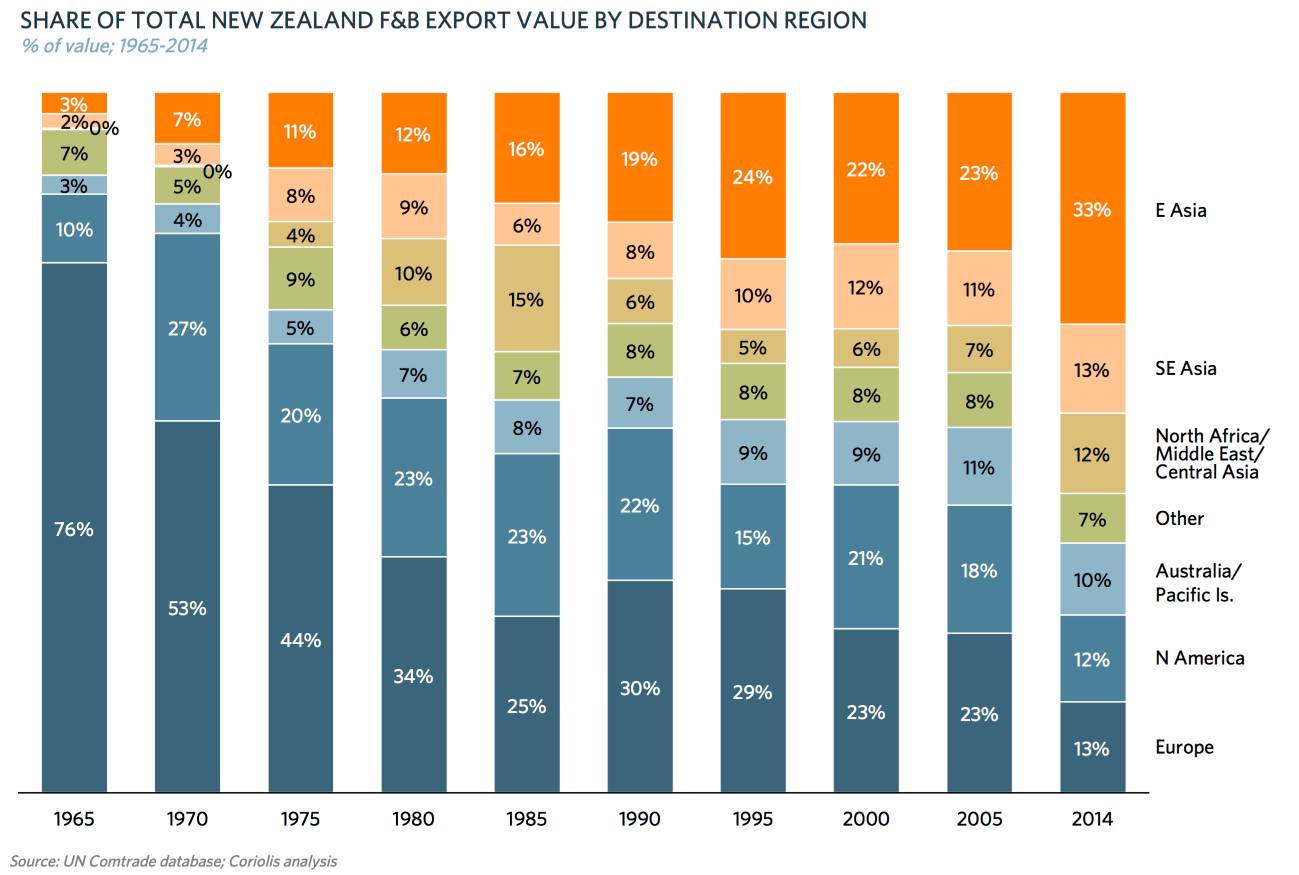
China is the biggest growth market for us – in both dollar and in percentage terms. That’s been a wonderful story of the benefits of our very early free trade agreement with China.
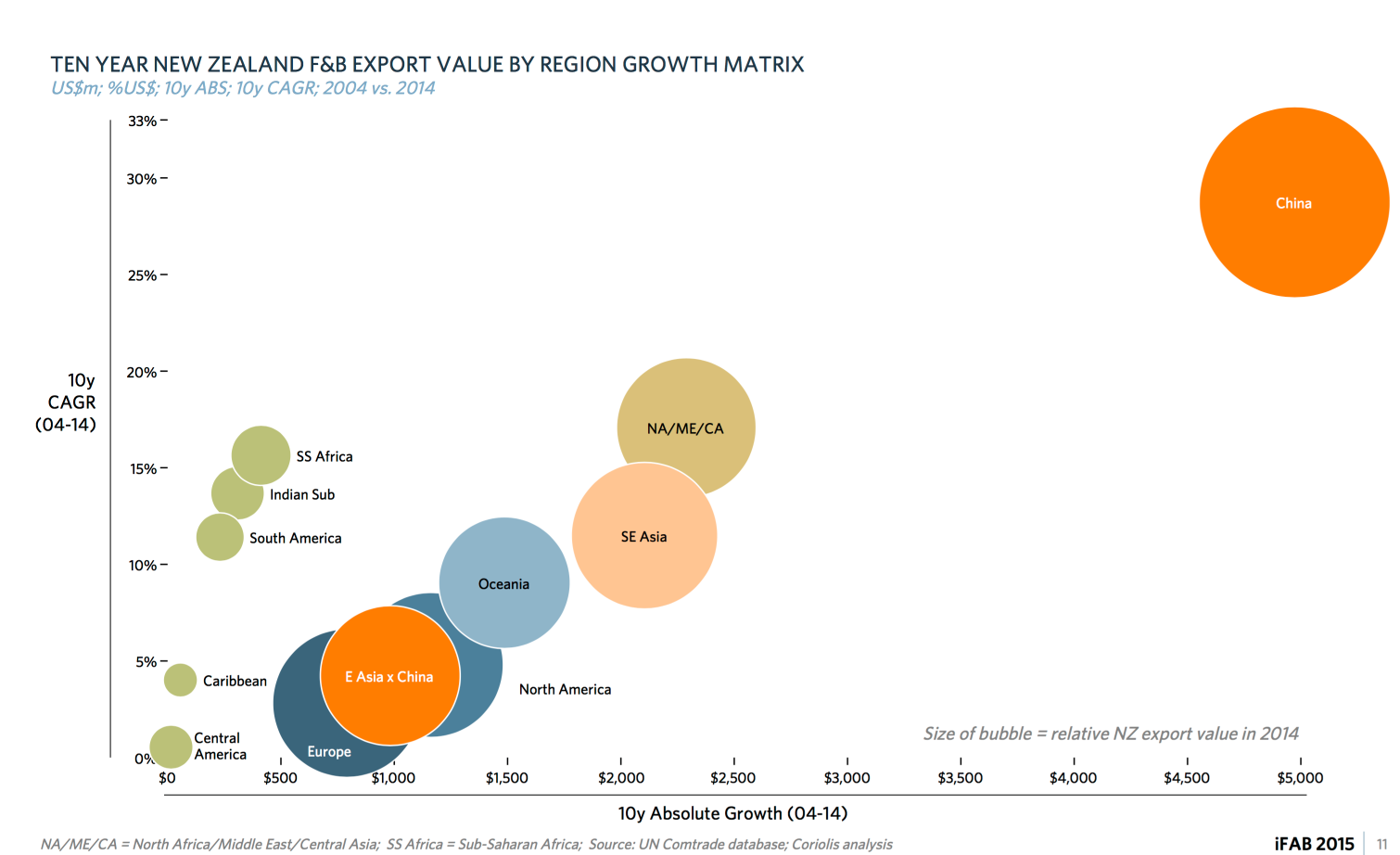
We are not the only food producer of course, and the giant exporter to worry about is the USA. Their absolute and percentage growth rate of exports is vast, and with TPPA they now have the ability to break open markets. In dollar terms the TPPA, which does not deal with their massive trade-supporting farm subsidies, will mainly be for the benefit of them.
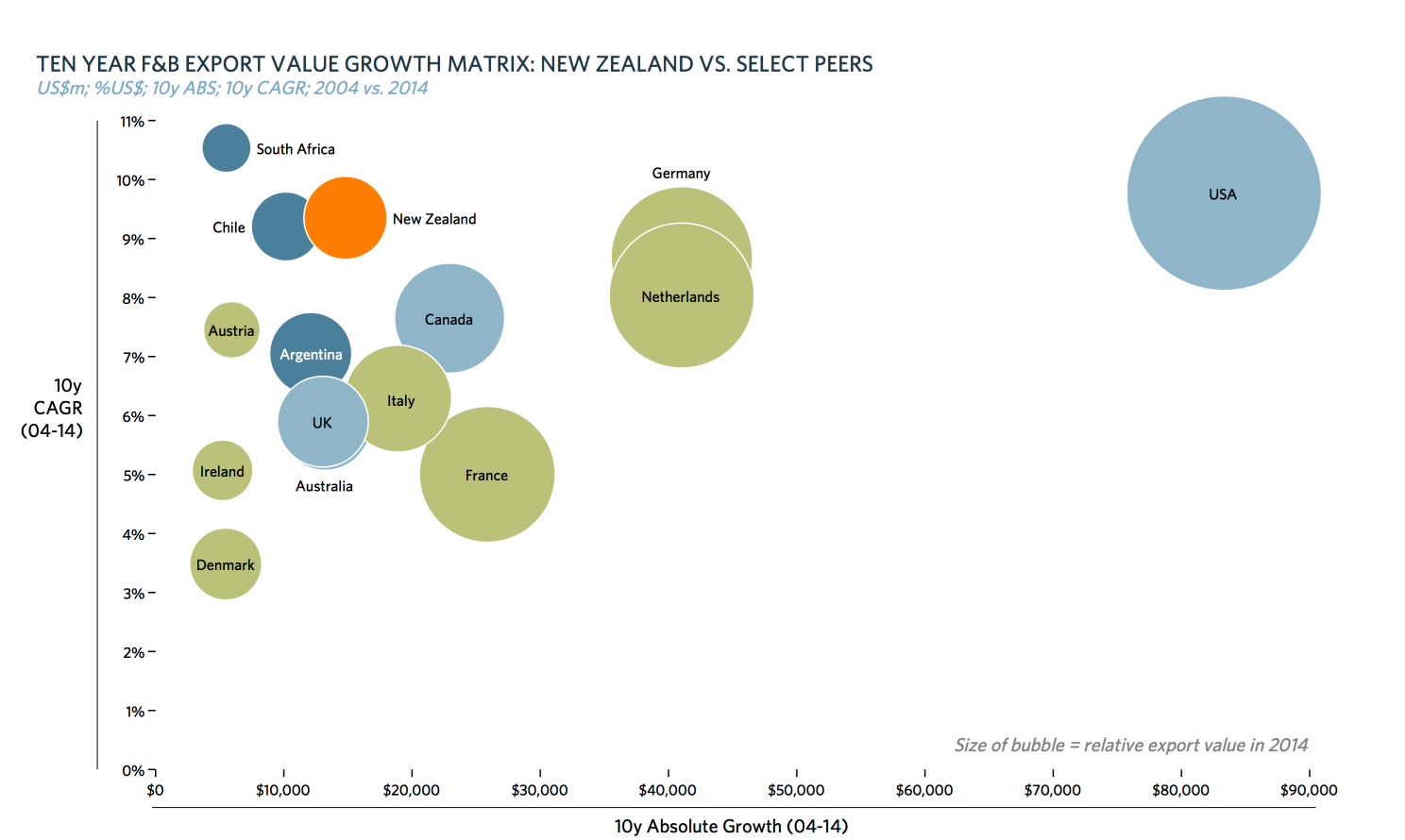
The USA’s food system is largely one of production prioritised over quality, with hormones and antibiotics added to animals producing meat and milk, subsidised corn and sugar quotas leading the prevalence of high fructose corn syrup (HFCS) and outcomes of obesity, poor health and antibiotic resistant bugs.
New Zealand can’t hope to compete on quantity with the USA, and while our food quality here is still pretty good, one downside of these trade agreements is that people in NZ will increasingly be offered cheaper poorer quality food sourced from offshore, and that will lead to worse health outcomes for NZ (which in turn will drive worse economic outcomes).
We can and should maintain and even lift our food quality standards – but can we do so under our free trade agreements? An infamous example is Mexico being forced to open their soda market to the subsidised and cheaper HFCS sweetener. Meanwhile the US fiercely protect their own sugar producers, largely because of expat Cuban sugar growers in Florida – who wield great political power. This is at great expense to their people – with prices of refined sugar are 95% higher than global prices, and along with the subsidised HFCS that means HFCS has a large market share as sweetener in US processed foods.
The eventual result between Mexico and the USA was a negotiated settlement whereby the US largely maintains their highly protected sugar industry and Mexico still copes with HFCS imports and substitution of sugar for HFCS. A close read of the article on the settlement makes is somewhat disturbing as we consider the impacts of TPPA.
All these fascinating charts come from the MBIE funded Coriolis Investors Guide to the Food and Beverage Industry, a worthwhile effort.
However i is a little misleading when assessing NZ’s potential to grow food production. For example, the chart below compares food production per square km between countries with varying demographics, geography and protected lands. (Other charts show production per population – again not a useful metric)

The key differences between the Netherlands and NZ go beyond our rugged terrain and highest point of 3,726 meters versus the famously flat Netherlands and a highest point of 894 meters.
The Netherlands, data from the World Bank shows, has just 11.1% of land covered by forest, but NZ has 38.6%. Meanwhile 38.6% of land in the Netherlands is arable, while NZ has just 2.1%. Are we to chop down forests?
I do not doubt that we can get more production out of NZ, even if we don’t touch the forests. But that will need to be balanced with efforts to increase positive environmental outcomes and margins, and our resources are not as limitless as the chart above implies.
Out food is seen as cheap and safe by markets.
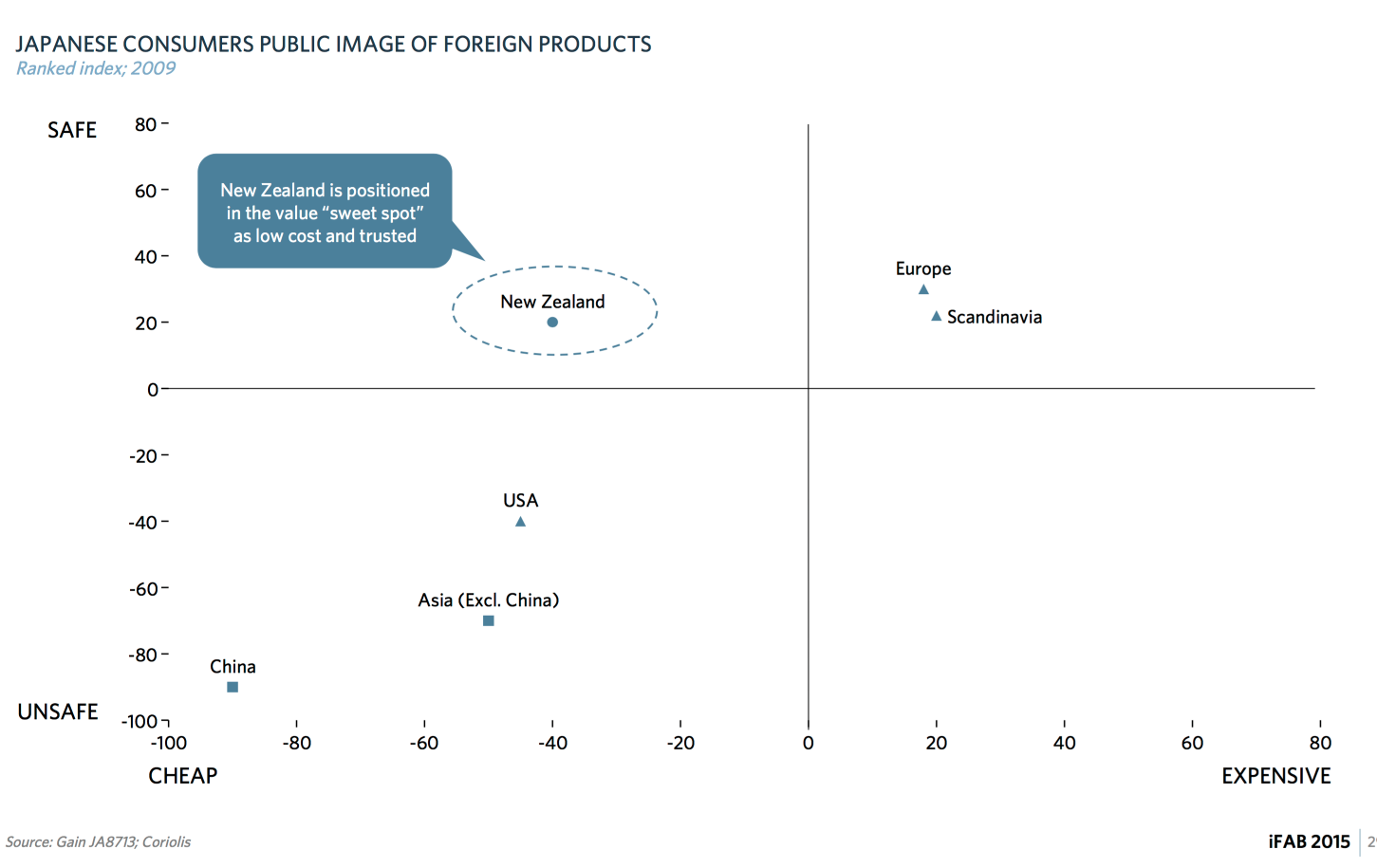 This is a problem but a good one. It shows the opportunity to receive considerable margin by moving to the prestige position.
This is a problem but a good one. It shows the opportunity to receive considerable margin by moving to the prestige position.

How do we do this? The answer starts at the farm. My favourite case study recently is Lewis Road Dairy – who charge outrageous amounts for their milk products sourced from an organic farmer. Their products are often sold out, and Fonterra eventually responded <correction – it was Goodman Fielder. So Fonterra is still left well behind> to Lewis Road by providing their own Puhoi branded organic milk. That’s good news for everyone, and now the real switch needs to happen at the farm level – with higher prices for organic milk (or milk/meat without palm kernels feed) driving farmers to switch their behaviour. These higher quality products sell locally and globally at super-premium prices, and there is considerable potential for New Zealand to capture and own the space globally.
What can we do as consumers?
As consumers we should demand quality foods, and we should be asking or insisting that our food quality standards remain high. Lets not allow hormone-filled meat into NZ, or dairy products produced by cows stuffed with antibiotics. Let’s reward good behaviour – e.g. by supporting McDonalds’ efforts to increase their food quality, by paying more for organic (and much tastier) food, and even switching supermarkets, as we did from the sadly declining Victoria Park New World, when high quality food disappears from shelves.
What can we do as investors?
This is something that entrepreneurs and investors can get involved with, as Lewis Road (and Firstlight Foods and others) have demonstrated that the incumbents, who are focussed on volume, can be disrupted by smaller producers and marketers. Eventually the bigger producers will lose their suppliers, or they will have to switch to higher quality inputs. We all know that a fancy packet, Silver Ferm Farms, does not change the quality of the contents.
At the back of the report is a hit-list of 200 companies. Private equity and other offshore money has made a few plays, but there are a substantial number of very high quality companies that are tightly held. Some of my favourites, such as Balle Brothers, and Dairy Goat Farm, will never sell, but there are plenty of opportunities for those with very large check books. Sadly those investors are mainly from offshore, and NZ has very little capital at work to support high growth businesses of any type. But that’s another issue.
Yes we can
It might take time, but the report does show that the farmers and growers will respond to market demand. The challenge is whether we can, as a society, help our food business ecosystem accelerate the change to owning the global high margin premium food position.
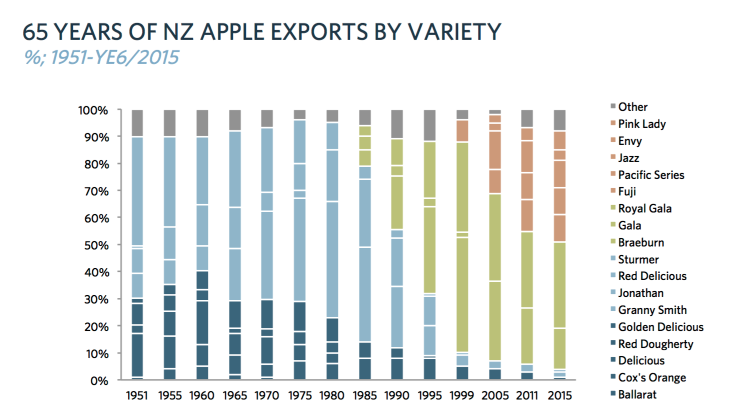

Great article, Lance. Perhaps you could write an annual follow-up to this as things progress. Do you know where NZ sits within the global organic food market?
LikeLike
I’ll leave that to MBIE – who commissioned the report.
LikeLike
Please don’t confuse organic with Quality. Organic is often less healthy and is in every case more demanding of the environment (while also requiring substantially more land). It’s no better ‘quality’, just good marketing.
New Zealand’s environment needs not be our number one priority, we don’t want to end up down another rabbit hole like Dairy. Where we so aggressively invest in one sector, that we feel the need to cling to it even while it’s rapes our entire eco system from the inside.
In all other regards this is a fantastic and well written piece, I’ll be bookmarking the blog :)
If you require citations for my anti-Organic claims I’ve linked them below:
Blogs:
http://www.independent.co.uk/environment/green-living/the-great-organic-myths-why-organic-foods-are-an-indulgence-the-world-cant-afford-818585.html
http://blogs.scientificamerican.com/science-sushi/httpblogsscientificamericancomscience-sushi20110718mythbusting-101-organic-farming-conventional-agriculture/
Scholarly Articles:
http://annals.org/article.aspx?articleid=1355685
http://ajcn.nutrition.org/content/92/1/203.long
http://ajcn.nutrition.org/content/90/3/680.full
LikeLike
It depends on the category, but as Whole Foods in the US knows well organic is a proxy for for grown by people who care about quality over quantity.
And that’s what NZ needs to be – the Whole Foods of the world. We should be renowned as a country where we care deeply about the quality of our food, the way it is grown (or raised), the flavour, nutrition and health and environmental outcomes it creates and making sure our lowest quality exports are better than everyone else’s highest. There are plenty of exporters who are well on the way to getting there.
LikeLike
Lance, not sure if New Zealand will benefit from the TPPA more than it will suffer, as the TPPA serves the interests of the US far too heavily. It certainly won’t help us with China and other markets that the US is competing with. The TPPA seeks to radicalise the globalisation of US interests and invariably this means trouble for local markets, industry, and populations. People are ignoring the hooks imbedded in the carrots being dangled by proponents of the TPPA. The level of ignorance amongst New Zealanders towards the TPPA is significant and disturbing. It doesn’t help that there is secrecy and deeply veiled attempts to hide the significant parts of the TPPA that will harm New Zealand (and other target countries) quality and way of life. We want improvement, not invasive business, law suits and changes to our policies and political culture to benefit foreign interests a little too much.
Fraser, experience and significantly more exhaustive research will show that there is far more to organic farming and crops than mere quality (quality is just one expression of the output, which is just the tip of the iceberg). The biggest aspect we need to consider about organic is the diversity and the practitioners’ deep consideration for sustainability and impact on environment. One reason why organic struggles with scale. Conventional farming and crops forces a manufacturing model onto the cultivation of natural resources and that impact has dire long-term consequences. The over-toxification of our environments is very, very easy to understand and has been understood for a long time.
Another significant impact of organic practices is the influence it has to drive technology, techniques, and new understanding to improve the scale and success of highly sustainable and diverse crops. Combining organics with technology, and removing chemicals (and subsequently remove the need for genetic modification and patented crops), is the smartest innovation New Zealand can use and export. We don’t need the US practices which are ham-fisted and seek to hammer a square peg into a round hole (forcing destructive manufacturing practices onto natural resources).
Without a diverse organic perspective, New Zealand crops and farming we can kiss goodbye to 100% New Zealand Natural (if it hasn’t already, with the signing of the TPPA and our careless welcoming of foreign big businesses which exhibit a disturbing level of self-interest and disregard for our natural resources and local population).
LikeLike